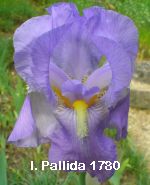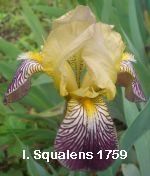|
The
Dutch scholar, physician and
botanist Charles de l’Écluse (lat. Carolus Clusius) 1526 - 1609
has described 28 Iris germanica types over 400 years ago. However, it was probably the time not ripe, to attend to the iris breeding.
This
changed in 1830. At the
beginning of the known
iris breeding it
was so,
that the first breeders
who were mostly rather
botanists as a gardener,
not deliberately crossed
himself but natural
and selected hybrids from
her garden, which reached
through
insect pollination, gave
names (at
the beginning -
professionally in the old botanical school - Latin names)
This is also shown in
the first attempt of the AIS (American
Iris Society) to compile a book who listed all known iris. This book
was issued 1929. The next book in 1939 has
already been completed
with thousands new entries, changes
and corrections. |
|
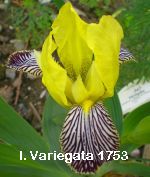
|
Since it at this time
no registration authority gave, all the informations was collected for
years. The infos comes mostly from seed catalogs, breeders and gardeners as
well as books and
magazines about iris. In the book of 1939 there is found very often renamings on already existing name,
and so the same Iris should not available under different names. Often,
Iris have been registered until years after the death of the breeder,
so they
then came
in the trade. In the first time, the iris were registered with the year of
the first known publication. |
|
As the iris breeders had available a collection of various iris, they let do the breeding work by insects
and selected from the resulting hazard seedlings varieties for trade. From about 1870, the breeder crossed himself and tried to breed by diverse aspects.
The irises were subsequently diverse, colorfull, the flowers were larger and of a few dozen natural hybrids are originated to this day more then 60000, registered by AIS. |
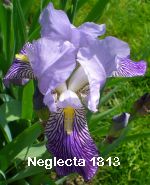
|
|
|
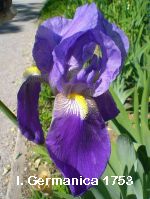 |
The really historical Iris not only Iris cultivars
but often also irises, which by botanists on their travels, were collected from the natural habitat and named.
At the same time there are some iris varieties that were probably cultivated for centuries in the gardens.
According to current knowledge are this natural random intersections. They were already so widespread
that previous botanists thought they were separate species. |
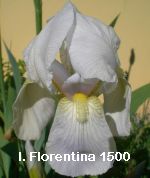 |
|
|
|
As well on the communication at that time, of course, had not our current pace. Over the years some irises have been , repeatedly described and named by various botanists.
Thus we now have the situation that some botanical iris among multiple names (synonyms) is commercially available. |
|
The
pictures show some ancestors
todays
bearded iris cultivars
(The year in the pictures do not mean that this iris has been bred in that year, but this iris the first time was mentioned by name in a botanical treatise in this year. The iris itself is certain older for many centuries or even millennia.) |
|
|
|
|
|
| |
One word to the pictures general: I have made photos in different parcs and gardens in europe, even at gardeners and breeders.
Particullary for historical iris the originality is not garanteed every time.
In the last 7 years in find again and again discrepancies
when I comparing the pictures of iris with the self name. Here I have tried to find other credible sources to comparing images;
and/or AIS-Registry (which particularly didn't give many informations to describe the iris before 1950)
to consult and have ultimately sometimes decided by the credibility of the source.
So sometimes can be the result an error. I am always happy to get help on the identification and especially when I get photos of iris which I haven't. |
|
| |
One word to the breeders- and registry-dates:
-
In the beginning of the AIS ther were not
always correct informations to year of breeding and introduction of a iris available.
Sometimes
it had to be
estimated. This
results in two flat annual figures that come up again and
again: '1859'
or 'before 1859' - if the iris is sure older; and '1939' - if it
haven't a year in the AIS-Registry from 1939. So 1939 the iris real
exist.
-
You will notice sometimes, that one or another Iris have a year of registration, this is often many years after the death of the breeder.
This seedlings are registered later by family or other breeders if the seedling is worthy to introduce
-
The information on the breeds before 1939 will be unfortunately incomplete in most cases, as far listed in the AIS reference of 1939 over 10000 iris, they allegedly no longer commercially available or are considered gone lost or destroyed.
These iris are actually no listed again, but make also constitute a breeding performance - and some of this iris are exist in european collections
|
|
Chronik / Workflow
|
